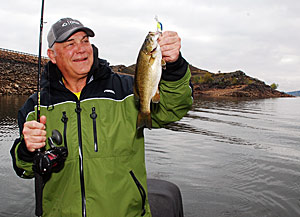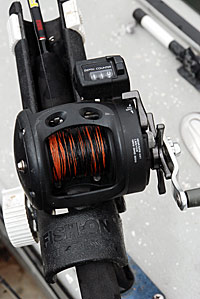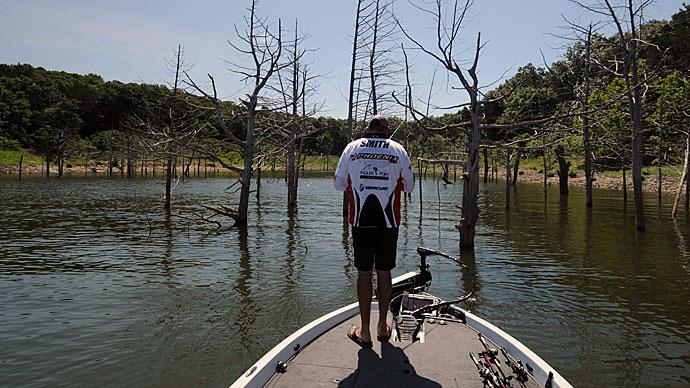
The one thing that’s never constant on reservoirs is water levels. They are constantly moving up and down. In the fall, the trend is mainly down. In the West, water levels are dropped to accommodate run-off from snowmelt the following spring. Smallmouth bass living in rocks, boulders, and patrolling ledges along the shoreline are suddenly forced offshore to deeper water. There, the bass can suspend below schools of baitfish or root out crayfish and minnows forced out into the reservoir. The problem with locating bass this time of year is they can be about anywhere from top to bottom.
Many bass anglers may have never heard or even know what lead-core line is. Lead-core line has a lead center and a Dacron sheath around it. The line is designed for trolling and sinks, depending on how much line you let out. Lead core changes colors every 10 yards so you can tell how much line you have out and how deep your lure is. Lure depth depends on the lure you have on and how fast you’re trolling.

Most bass anglers would think that lead core doesn’t have many applications in bass fishing. Most bass anglers would agree that they’d instead cast than troll when it comes to catching bass. But trolling lead core has some applications that most bass anglers wouldn’t think of. When reservoir levels quickly drop, bass are forced to move almost daily. That can make them tough to find from one weekend to the next. As water temperatures cool in the fall, bass change locations from shallow summer hunting grounds to deeper isolated winter haunts and can be anywhere in between, depending on the season and water temperature. Finding them on any given day can be difficult.
Trolling with lead core can be a proven way to discover fall smallmouth patterns. One reason is that you can run multiple lines at multiple depths to determine precisely where bass are lurking. Most states allow anglers to use multiple lines. While some bass anglers may not even have rod holders on their boats, placing some rail-mount rod holders on the boat is simple. Some boats have built-in recessed holders that can be used. Lead-core line is relatively inexpensive. It comes in various pound tests, but 18-pound is the most used. It’s pretty easy to add lead core to any old bait casters you might have.
With four rods out, anglers can cover multiple depths, cover water via trolling and present four different lures at one time. You can’t do that casting. To increase your coverage area, run the lead core off in-line planers boards. Doing so increases your coverage tenfold and lessens the chance for tangles.

I joined Brad Petersen a short time ago to pre-fish for a walleye tournament on a western reservoir. The water managers had been dropping the water levels on the reservoir approximately a foot per day for more than a month. The reservoir was down 48 feet and falling. Rocks and boulders that had once been the most productive areas were now high and dry.
Brad elected to troll with lead core to see if we could hit on a walleye pattern. Fishing had been slow, except for the occasional smallmouth that everyone had reported catching. Brad was running two lead-core lines in rod holders off each side of the boat. We’d trolled quite a ways before one of the rods out 110 feet started to jump. The next question was, “What is it?” The rod was thumping pretty good for it to be a walleye. My bet was on a brown bass. Halfway to the boat, the fish came clear of the water, confirming our suspicions. The smallie had jumped on a Rapala micro-crankbait in a baby bluegill color. Brad immediately put a similar-sized crankbait on the other side.
We hadn’t gone far when the same rod started banging again; another fat smallmouth. Soon, the other rods started hammering, and before long, we’d caught fish on all four rods we had out all smallmouths. It was all we could do to let lines out, unhook fish and get the lures back out. The bass ranged from dinks to 14 or 15 inches, but Brad said he had caught smallies up to 17 or 18 inches from this reservoir. We never caught a walleye, but the smallmouth made for a fun day.
You don’t need much in the way of specialized equipment to run lead core. Petersen uses short, 6-foot rods. I prefer longer rods. Old bait-casting rods will work if they fit in a rod holder. Some anglers prefer longer rods to get lines farther away from the boat. Line-counter reels help track how far lines are out, but because the lead-core line is color-coded, you count the colors to know how much line is out. You can run anything you’d like as far as lures go on lead core: cranks, stick baits, spoons, even plastic. You can set a buffet and let the bass tell you what they want.
Bass anglers may not consider trolling lead-core line as a preferred method for catching bass. Still, the fact that you can run multiple lines and cover lots of water and specific depths while presenting a smorgasbord of lures makes it a viable alternative for locating suspended fall bass.




